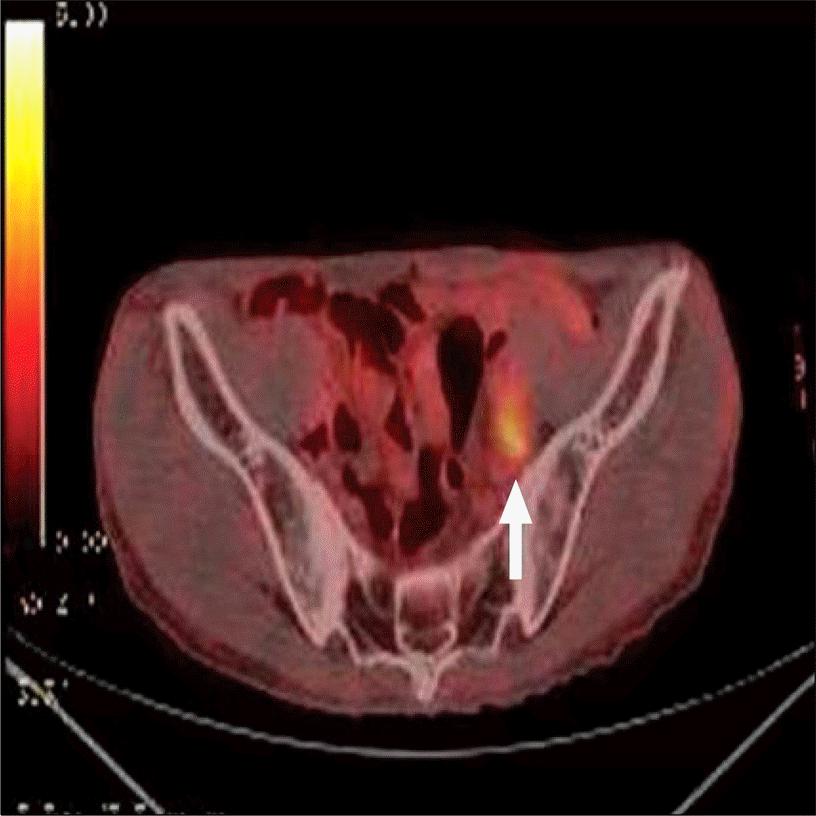Abstract
Schwannoma is a benign neoplasm of the Schwann cells of the neural sheath. Most schwannomas occur in the head and neck, and extremities and rarely in the retroperitoneal space. The differentiation of a schwannoma from other malignant tumor or benign tumor is very difficult on a preoperative examination with ultrasonography, computed tomography or magnetic resonance imaging. Furthermore, the lesion with increased fluorodeoxyglucose uptake in PET-CT cannot exclude malignant tumor. Therefore, this lesion needs surgical excision and a histological examination with immunohistochemical staining. We report a case of schwannoma occuring in the retroperitoneal space that incidentally discovered by PET-CT for health-check up. Pathologic confirmation by laparoscopic excision was done.
Go to : 
References
1. Stefansson K, Wollmann R, Jerkovic M. S-100 protein in soft-tissue tumors derived from Schwann cells and melanocytes. Am J Pathol. 1982; 106:261–268.
2. Thurnher D, Quint C, Pammer J, Schima W, Knerer B, Denk DM. Dysphagia due to a large schwannoma of the oropharynx: case report and review of the literature. Arch Otolaryngol Head Neck Surg. 2002; 128:850–852.
3. Sharma SK, Koleski FC, Husain AN, Albala DM, Turk TM. Retroperitoneal schwannoma mimicking an adrenal lesion. World J Urol. 2002; 20:232–233.

4. Das Gupta TK, Brasfield RD, Strong EW, Hajdu SI. Benign solitary Schwannomas (neurilemomas). Cancer. 1969; 24:355–366.

5. Hide IG, Baudouin CJ, Murray SA, Malcolm AJ. Giant ancient schwannoma of the pelvis. Skeletal Radiol. 2000; 29:538–542.

6. Schindler OS, Dixon JH, Case P. Retroperitoneal giant schwannomas: report on two cases and review of the literature. J Orthop Surg (Hong Kong). 2002; 10:77–84.

7. Lee TY, Park JS, Sung YR, et al. A case report of neurilemmoma of the chest wall. Tuberc Respir Dis. 1997; 44:649–654.

8. Singh V, Kapoor R. Atypical presentations of benign retroperitoneal schwannoma: report of three cases with review of literature. Int Urol Nephrol. 2005; 37:547–549.

9. Funamizu N, Sasaki A, Matsumoto T, Inomata M, Shiraishi N, Kitano S. Laparoscopic resection of a retroperitoneal schwannoma behind the lesser omental sac. Surg Laparosc Endosc Percutan Tech. 2004; 14:175–177.

10. Kinoshita T, Naganuma H, Ishii K, Itoh H. CT features of retroperitoneal neurolemmoma. Eur J Radiol. 1998; 27:67–71.
11. Li Q, Gao C, Juzi JT, Hao X. Analysis of 82 cases of retroperitoneal schwannoma. ANZ J Surg. 2007; 77:237–240.

12. Kawahara E, Oda Y, Ooi A, Katsuda S, Nakanishi I, Umeda S. Expression of glial fibrillary acidic protein (GFAP) in peripheral nerve sheath tumors. A comparative study of immunoreactivity of GFAP, vimentin, S-100 protein, and neurofilament in 38 schwannomas and 18 neurofibromas. Am J Surg Pathol. 1988; 12:115–120.
13. Tokunaga T, Takeda S, Sumimura J, Maeda H. Esophageal schwannoma: report of a case. Surg Today. 2007; 37:500–502.

14. Beaulieu S, Rubin B, Djang D, Conrad E, Turcotte E, Eary JF. Positron emission tomography of schwannomas: emphasizing its potential in preoperative planning. AJR Am J Roentgenol. 2004; 182:971–974.

15. Shah N, Sibtain A, Saunders MI, Townsend E, Wong WL. High FDG uptake in a schwannoma: a PET study. J Comput Assist Tomogr. 2000; 24:55–56.
Go to : 
 | Fig. 1.PET-CT finding. On left pelvic area, hypermetabolic mass (max SUV 3.7) (arrow) with increased FDG uptake was seen. |
 | Fig. 2.Abdominal CT finding (enhanced image). Focal target-like mass (about 3×2 cm) (arrow) in adjacent to left pelvic bone was seen. |




 PDF
PDF ePub
ePub Citation
Citation Print
Print




 XML Download
XML Download